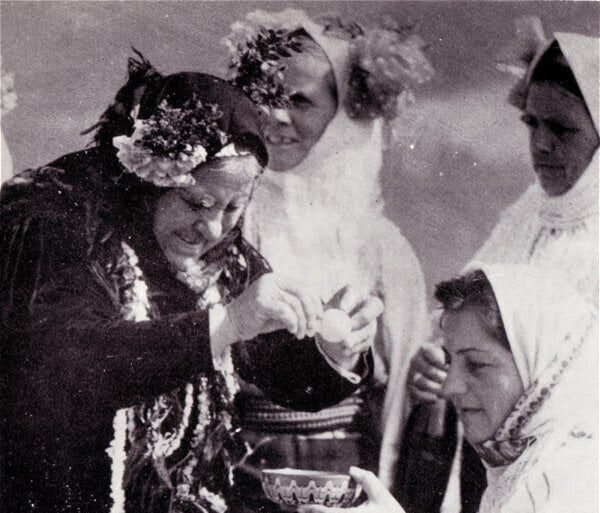- the orientals: Russians, Belarusians and Ukrainians, to which are added smaller groups such as the Ruthenians, the Houtsoules and the Lipovenes.
- the Westerners: Poles, Czechs and Slovaks, to which are added smaller groups such as the Sorbs, the Kashubians and the Silesians.
- the southerners: Slovenes, Croats, Bosniaks, Serbs and Montenegrins, Macedonians and Bulgarians, to which are added smaller groups such as the Pomaks and the Carashovenes.

Contents
ToggleHolidays of the Slavic peoples
Holidays of the month
January 5, 2025 (1 event)
January 5, 2025

Today, the Serbs make Tucindan. Pagan festival adopted by the Orthodox Church, the Serbs make Tucindan on Christmas Eve. For the pečenica, the men choose a pig and feed it with better fodder for one or two months before Christmas. This animal is killed in Tucindan by hitting it on the head with a piece of salt. #calendar #5January #mythology #myth #legend #orthodoxchurch #serbia #montenegro #tucindan
January 6, 2025 (1 event)
January 6, 2025

Today, the Serbian peoples celebrate the Koleda (December), the Russians celebrate it in January. The koleda was a custom in which a group of young men, masked and costumed, went from house to house in their village singing special koleda songs and performing acts of magic intended to invoke health, wealth and prosperity. prosperity for every home. #mythology #myth #legend #calendar #21December #6January #Serbia #Slavic #koleda #korochun
January 8, 2025 (1 event)
January 8, 2025

Today, Bulgarians celebrate Babinden, in honor of midwives. This profession is very respected because the lives of newborns depend on it. Of pagan origin, the Slavs always continue to thank midwives. #mythology #myth #legend #calendar #8January #baba #babinden
January 13, 2025 (1 event)
January 13, 2025

Today, Russians celebrate Malanka. Equivalent to New Year's Eve, this holiday originates from the pagan traditions of the return of spring. #mythology #myth #legend #calendar #13January #russia #ukraine #malanka
Slavic cultural areas
Slavic mythology refers to the system of cosmological and religious beliefs of the ancient Slavic peoples before their evangelization. It has evolved for more than 3000 years. Its elements come, according to hypotheses, from the Neolithic, or even perhaps from the Mesolithic. This religion has many points in common with religions descended like it from the Proto-Indo-European religion.
Unlike Greek or Egyptian mythology, we do not have first-hand documents to study it. Religious beliefs and traditions would therefore have been perpetuated by oral transmission between generations, then partly forgotten over time after evangelization. Our current sources are those of non-Slavic Christian missionaries, neither interested in it, nor objective in their descriptions of ancient rites.
The first written mention of Slav mythology is Procopius of Caesarea who, in the 6th century, in his Bellum Gothicum, describes the beliefs of certain tribes of the southern Slavs who had crossed the Danube. According to him, they would have been monotheists and although he does not mention any name, specialists connect this unique god to Perun. He also mentions the belief in numerous demons and in nymphs (vila, roussalka, vodník).
The Chronicle of Bygone Times is the most important source, if only because it is written by native people. Compiled in the 12th century, it references and includes copies of older documents. Two gods, Perun and Veles, are mentioned in the peace treaty signed at the beginning of the 10th century.
Nestor the Chronicler describes the pantheon of Prince Vladimir I before his conversion: it includes Perun god of lightning and war, Dajbog god of time, bad weather and duration, Stribog god of the wind, Khors god of the sun, Simargl god -griffin of fire, night, moon, crops and plants, and Mokoch goddess of fertility. This painting characterizes the final period of the Slavs, in a heroic and already feudal type culture. Political religion predominates there.
In the 11th and 12th centuries, Germanic chroniclers such as Thietmar of Merseburg, Adam of Bremen or Helmold von Bosau, in his Chronica slavorum, mentioned certain deities of the Wends. The least we can say is that these sources, contemporary with Christianization and the vassalization of the Wends, are neither objective nor very detailed with regard to beliefs considered impious.
Helmold mentions the "demon" Chernobog, Jiva goddess of fertility, Porenut four-headed god and Svantovit worshiped by the Abodrites at Cape Arkona and mentioned as being the most important of all for these peoples.



